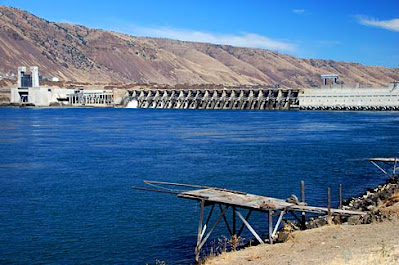A Deeper Look: Sherman County
 |
| John Day Dam, Sherman county. Fishing platform |
On our trip to Hermiston last week we drove through
Wasco County, then Sherman, which was once part of Wasco. When Wasco was formed
in 1854 it was the largest county ever formed in the United States and
stretched from the Washington border to the California border, and from the
Cascade to the Rocky Mountains. 17 Oregon counties were later created from it,
including Sherman in 1889. Moro is the county seat.
In the 1880’s there was a “reverse migration” of
settlers who arrived in the Willamette Valley only to find the best land
already taken. They moved east and began farming and ranching on the dry
eastern side of the Cascades. Some immigrants just stopped there and didn’t go
on to the western side of the mountains. Enough population settled in this
corner of Wasco County in the 1880’s that they petitioned to be a separate entity.
Even now, however, the population is not large. The 2020 census recorded 1,870,
making it the second-least populated county in the state after Wheeler.
 |
| Sherman County |
The original natives of Sherman County were the Tenino
people, now called “The Warm Springs Bands.” There were four separate groups of
Tenino, living along the Columbia between Celilo Falls and the John Day River.
They wintered along the river and spent summers inland foraging for various
food and trading resources. Lewis and Clark encountered them during their
overland journey, and even employed some Tenino natives for a short time when
they needed help along the river.
In 1855 Superintendent of Indian Affairs, Joel Palmer,
negotiated the Treaty with the Tribes of Middle Oregon, which relocated
the Tenino, along with members of the Wasco and Northern Paiute, to the Warm
Springs Indian Reservation. The three tribes are now part of the Confederated Tribes
of Warm Springs.
While the Tenino and Wasco traditionally were on
friendly terms and lived similar lives, the Paiute were from further east, had
a different lifestyle and spoke an unfamiliar language. Encounters with the
Paiute often led to hostilities. Creating a working relationship on the
reservation must have been challenging.
The relocation of the Tenino placed them mostly out of
their former homeland, although a portion of the Warm Springs Reservation is in
Sherman County. Most of the reservation lies in Wasco and Jefferson with parcels
in several other counties.
The main population center on the reservation is the
town of Warm Springs. At one time there was a resort, Kah-Ne-Tah Resort and
Spa, that closed in 2018. There are now plans to reopen portions of it in 2023.
Other enterprises include the Indian Head Casino at Warm Springs, as well as
forestry, construction, and fishery businesses. The Confederated Tribes are governed
by an 11-member Council. 8 members are elected and the other three are lifetime
chiefs representing each of the three tribes.
How do we pray for Sherman County?
Let all creation rejoice before the Lord, for he comes, he comes to judge the earth. He
will judge the world in righteousness and the peoples in his faithfulness. Psalm 96:13
Pray for the County Commissioners, Judge Joe Dabulskis, Commissioners Joan Bird and Justin Miller, and Sheriff Brad Lohrey.
On the Warm Springs Reservation, the Tenino chief is
Delvis Heath (Warm Springs Bands). Pray for him and the other Council members
as well as the Paiute Chief, Joe Moses, and the Wasco Chief, Alfred Smith, Jr.



Comments
Post a Comment